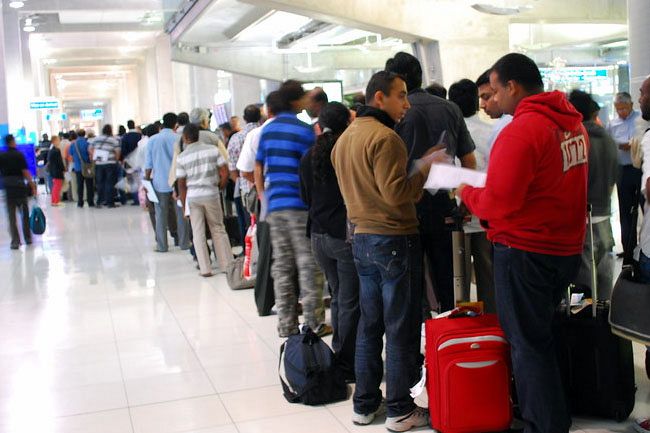Net migration figures have shown a slowing down of entrants into Australia, but not enough to satisfy the Albanese Government, writes Dr Abul Rizvi.
WITH OPPOSITION LEADER Peter Dutton ramping up the rhetoric on high immigration levels and calling students appealing refusal decisions and applying for asylum the ‘new boat arrivals’, the Albanese Government is desperate to see net migration fall. And it did fall in the September quarter of 2024 compared to the September quarter of 2023 — but not by the rate the Treasury has forecast.
Last week, the Australian Bureau of Statistics (ABS) published net permanent and long-term (NPLT) data for September 2024 giving us a full quarter of data on NPLT for 2024-25. Note NPLT is the earliest approximation of net migration that the ABS publishes.
Net migration for the first three quarters of 2023-24 plus NPLT data for the June quarter of 2024 suggests that for 2023-24, net migration was around 460,000 compared to the Treasury forecast of 395,000.
The Treasury’s latest net migration forecast for 2024-25 is 260,000. In other words, a decline in net migration of around 200,000 or over 42%. However, NPLT for the September quarter of 2024 was only 14% below that of the September quarter of 2023.

NPLT arrivals fell only marginally by 2,140. Given the significant measures to reduce the rate of growth in overseas students, this would be a disappointing outcome for the Albanese Government.
NPLT departures increased more strongly, likely due to an increase in departures of students, temporary graduates and COVID visa holders. However, the increase in departures was not nearly at the level the Treasury is relying on for its net migration forecast of 260,000 in 2024-25.
Based on NPLT for the September quarter of 2024 and if the labour market remains strong, it is very unlikely net migration will fall to 260,000 in 2024-25. It is more likely to be around 350,000 or more. That will cause problems for the Albanese Government.
Temporary entrants in Australia
Another way to look at net migration trends is by focusing on changes in the stock of temporary entrants in Australia.
If the Government is to get net migration down to the levels forecast by the Treasury, it needs to reduce the rate of growth in temporary entrant stocks. The growth in stocks of temporary entrants is slowing. Still, it will have to slow much further to hit the Treasury’s net migration forecasts and to prevent larger numbers of people ending up in immigration limbo. Note the September quarter tends to be a strong growth quarter for temporary entrants so just multiplying the outcome for the quarter by four is misleading.

There are three ways the above numbers can change:
- A temporary entrant secures another temporary visa: the big growth in bridging visas is hiding some of the growth in students (there are over 110,000 onshore student visa applicants in the bridging visa backlog) while the fall in the temporary other group is driven by the closure of the COVID visa many of whom are now applying for other onshore visas, including student visas.
- A temporary entrant secures permanent residence or Australian citizenship: the growth in New Zealand citizens is actually faster than appears because of NZ citizens directly accessing Australian citizenship while the growth in skilled temporary entrants and temporary graduates is being masked by these temporary entrants securing permanent residence.
- A temporary entrant can depart: Australia’s strong labour market is slowing the rate at which temporary entrants are departing.
Ultimately, the Government will need to decide what is a manageable temporary entrant population as bringing down the stock of temporary entrants can involve major costs as the Canadian Government is now finding out. That is a situation we do not want to be in.
Bridging visas
The bridging visa backlog has again become a big problem for the Government and the Department of Home Affairs (DHA) in particular (see Chart 1). A large bridging visa backlog reflects an inability to efficiently process onshore visa applications, particularly onshore student visa applications. There are around 110,000 onshore student visa applicants in the bridging visa backlog, including over 17,000 who were at the Administrative Review Tribunal (A.R.T.) at end September 2024.

Student visas
The most recent DHA data on student visas confirms ongoing:
- weakness in offshore student applications (see Chart 2);
- high refusal rates in offshore student applications (around 20%); and
- strength in onshore student applications and low grant rates (see Chart 3).
Note that to reduce offshore student applications and grants, the Government doesn’t really need the proposed student caps. A better student visa processing regime would be far superior.


The large divergence between onshore student applications and onshore grants is a function of a high refusal rate (leading to a huge appeal rate to the A.R.T.) and slow processing leading to an onshore student visa application backlog of over 110,000. That is becoming a bigger and bigger political issue.
Peter Dutton has described it as a new version of boat arrivals. While that is nonsense, it will not stop Dutton from playing politics on the issue.
Dr Abul Rizvi is an Independent Australia columnist and a former Deputy Secretary of the Department of Immigration. You can follow Abul on Twitter @RizviAbul.
Support independent journalism Subscribe to IA.
Related Articles



